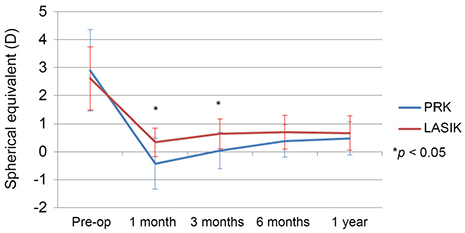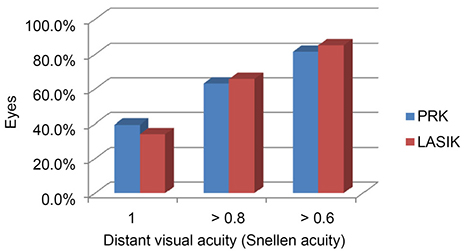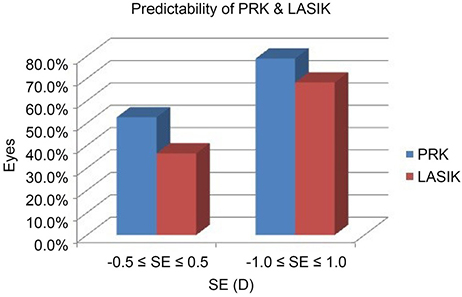J Korean Ophthalmol Soc.
2019 Jun;60(6):528-533. 10.3341/jkos.2019.60.6.528.
Comparison of Hyperopic Photorefractive Keratectomy and LASIK
- Affiliations
-
- 1Nune Eye Hospital, Seoul, Korea. cmchoe@gmail.com
- 2Nune Eye Hospital, Daegu, Korea.
- 3Department of Mathematics and Statistics, Johns Hopkins University, Baltimore, MD, USA.
- KMID: 2449705
- DOI: http://doi.org/10.3341/jkos.2019.60.6.528
Abstract
- PURPOSE
We compared the results of photorefractive keratectomy (PRK) and laser in situ keratomileusis (LASIK) for the correction of hyperopia.
METHODS
Patients who underwent PRK or LASIK, under +6.00 diopters (D) hyperopia and under −2.00 D astigmatism were included. In total, 21 patients (38 eyes) underwent PRK surgery and 25 patients (41 eyes) underwent LASIK surgery. We compared the visual acuity, refractive error, safety, and efficacy between the two groups.
RESULTS
The manifest refractive spherical equivalent (MRSE) of the PRK and LASIK groups at 1 and 3 months after surgery was significantly different between the two groups (p < 0.05). However, the MRSE was not significantly different at postoperative 6 and 12 months between the two groups. The uncorrected visual acuity (UCVA) of the PRK and LASIK groups at 1 month after surgery was significantly different between the two groups (p < 0.05). However, the UCVA was not significantly different at postoperative 3, 6, and 12 months between the two groups. The best-corrected visual acuity was not significantly different at postoperative 1, 3, 6, and 12 months between the two groups. The safety index was not significantly different between the two groups at postoperative 1, 3, 6, and 12 months. The efficacy index of the PRK group was lower than that of the LASIK group at 1 month after surgery. However, the efficacy index was not significantly different at postoperative 3, 6, and 12 months between the two groups. There was no statistically significant difference between the predictability of the two groups at postoperative 1 year.
CONCLUSIONS
After PRK treatment, temporary myopic deviation was observed after 1 month, but there was no significant difference between the two treatments after 3 months of follow-up. In the correction of hyperopia, there was no significant difference between PRK and LASIK in efficacy or safety.
Keyword
MeSH Terms
Figure
Reference
-
1. El-Maghraby A, Salah T, Waring GO 3rd, et al. Randomized bilateral comparison of excimer laser in situ keratomileusis and photorefractive keratectomy for 2.50 to 8.00 diopters of myopia. Ophthalmology. 1999; 106:447–457.
Article2. He L, Manche EE. Contralateral eye-to-eye comparison of wavefront-guided and wavefront-optimized photorefractive keratectomy: a randomized clinical trial. JAMA Ophthalmol. 2015; 133:51–59.3. Shortt AJ, Allan BD, Evans JR. Laser-assisted in-situ keratomileusis (LASIK) versus photorefractive keratectomy (PRK) for myopia. Cochrane Database Syst Rev. 2013; (1):CD005135.4. Hersh PS, Brint SF, Maloney RK, et al. Photorefractive keratectomy versus laser in situ keratomileusis for moderate to high myopia. A randomized prospective study. Ophthalmology. 1998; 105:1512–1522. discussion 1522–3.5. Han HS, Song JS, Kim HM. Long-term results of laser in situ keratomileusis for high myopia. Korean J Ophthalmol. 2000; 14:1–6.
Article6. de Ortueta D, Arba Mosquera S. Topographic stability after hyperopic LASIK. J Refract Surg. 2010; 26:547–554.
Article7. McGhee CN, Ormonde S, Kohnen T, et al. The surgical correction of moderate hypermetropia: the management controversy. Br J Ophthalmol. 2002; 86:815–822.
Article8. Azar DT, Primack JD. Theoretical analysis of ablation depths and profiles in laser in situ keratomileusis for compound hyperopic and mixed astigmatism. J Cataract Refract Surg. 2000; 26:1123–1136.
Article9. Primack JD, Azar DT. Refractive surgery for hyperopia. Int Ophthalmol Clin. 2000; 40:151–163.
Article10. Sher NA. Hyperopic refractive surgery. Curr opin Ophthalmol. 2001; 12:304–308.
Article11. Plaza-Puche AB, Yebana P, Arba-Mosquera S, Alió JL. Three-year Follow-up of Hyperopic LASIK using a 500-Hz Eximer Laser System. J Refract surg. 2015; 31:674–682.12. Shah S, Sheppard AL, Castle J, et al. Refractive outcomes of laser-assisted subepithelial keratectomy for myopia, hyperopia, and astigmatism using a 213 nm wavelength solid-state laser. J Cataract Refract Surg. 2012; 38:746–751.
Article13. Choi SH, Kim SJ, Kim MK, Wee WR. Short-term clinical results of hyperopic LASEK in Korean patients. J Korean Ophthalmol soc. 2015; 56:1527–1533.
Article14. Danjoux JP, Kalski RS, Cohen P, et al. Excimer laser photorefractive keratectomy for hyperopia. J Refract Surg. 1997; 13:349–355.
Article15. Ibrahim O. Laser in situ keratomileusis for hyperopia and hyperopic astigmatism. J Refract Surg. 1998; 14:2 Suppl. S179–S182.
Article16. Serrao S, Lombardo M. Corneal epithelial healing after photorefractive keratectomy: analytical study. J Cataract Refract Surg. 2005; 31:930–937.
Article17. Frings A, Richard G, Steinberg J, et al. LASIK and PRK in hyperopic astigmatic eyes: is early retreatment advisable? Clin Ophthalmol. 2016; 10:565–570.
Article
- Full Text Links
- Actions
-
Cited
- CITED
-
- Close
- Share
- Similar articles
-
- Combined Mitomycin-C Assisted Photorefractive Keratectomy in the Treatment of Epithelial Ingrowth after LASIK
- The Comparison between 5.0mm and 6.0mm Ablation Diameter in Surgical Result of Excimer Laser Photorefractive Keratectomy
- Comparision of the Clinical Results in Photorefractive Keratectomy with that in Laser In Situ Keratomileusis for Correction of Moderate Myopia
- Early Postoperative Pain and Visual Outcomes Following Epipolis-Laser In Situ Keratomileusis and Photorefractive Keratectomy
- Comparison of Refractive Outcomes of Broad Beam and Flying Spot Excimer Laser after Photorefractive Keratectomy




